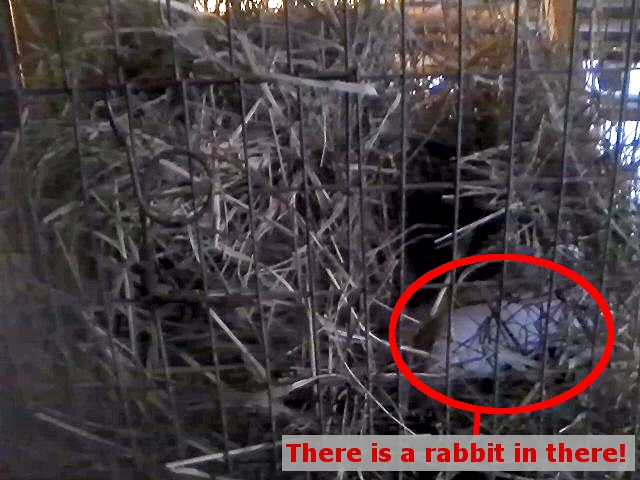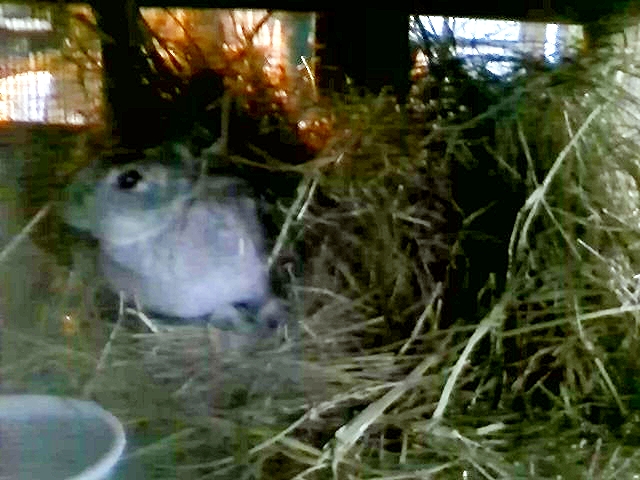I’m sorry for the delay in continuing my animal care tips. Last week was super busy, but hopefully things will begin to settle down around here as winter sets in.
Speaking of winter - I think it is arriving today. We started the day out with a high in the mid 40’s and the temperature has been dropping fast all day. The forecast is for us to end up in the low-mid 20’s tonight. Brrrrr!!! So in preparation for this, I bunked the rabbits down this morning.
Q: How do you keep your rabbits warm in cold weather?
A: Rabbits are surprisingly well adapted to cold weather. In fact, they tolerate cold temperatures much better than hot temperatures. Even with their thick fur coats however, domestic rabbits need assistance when the weather turns bitter.
The primary step is to ensure that the rabbits are protected from drafts. If they are inside a building, close off doors and windows, leaving just enough air flow (maybe a cracked window, or a vent fan) for ventilation. If they are not enclosed by a building, be sure the cages are protected. You can do this by installing some type of barrier, such as wooden boards or metal sheeting, around the outside of the cages to shield them. Depending on your set up, you may need to enclose each set of cages or, if it is possible, you can simply enclose the general area where your cages are. If they are under a shed for instance, you can tack plywood to each side. If you can be positive that the rabbits cannot reach to chew on it, you can wrap a shed in plastic sheeting or tarps. Whatever your method, the idea is to prevent cold air from blowing on the cages and chilling the rabbits. Still air feels warmer than moving air, and is easier for a rabbit to tolerate.
Depending on the weather conditions, blocking air flow may be all that is necessary. In my case, it is not possible to completely block air flow from the entire area where my cages are. I block what I can and then, as an added measure on exceptionally cold or windy days, I provide each rabbit with extra protection. Nursing does already have a nest box, and this provides added shelter to the doe. Generally, the kits in the next box have enough protection from their nest (hopefully well lined with mom’s fur) to protect them. If the doe burrows in the box to keep herself warm, this just provides added protection to her kits as well. Sometimes I will also provide dry does and/or bucks with a nest box stuffed with hay, simply for the added protection that it provides if the rabbit chooses to burrow in the box. The next thing I do is stuff each cage with plenty - and I do mean plenty - of hay, to help block air flow and to provide “fuel.” The rabbits will eat the hay (which means it must be replenished daily) and they will burrow in it as well. As they eat, the workings of their digestive system will generate heat, helping the rabbit to keep warm. Burrowing helps to block drafts, and provides insulation to help the rabbit retain the body heat that is generated as they eat. This, in combination with the hot water that I provide a minimum of twice daily, helps each rabbit to thrive even with temperature extremes.
Speaking of winter - I think it is arriving today. We started the day out with a high in the mid 40’s and the temperature has been dropping fast all day. The forecast is for us to end up in the low-mid 20’s tonight. Brrrrr!!! So in preparation for this, I bunked the rabbits down this morning.
Q: How do you keep your rabbits warm in cold weather?
A: Rabbits are surprisingly well adapted to cold weather. In fact, they tolerate cold temperatures much better than hot temperatures. Even with their thick fur coats however, domestic rabbits need assistance when the weather turns bitter.
The primary step is to ensure that the rabbits are protected from drafts. If they are inside a building, close off doors and windows, leaving just enough air flow (maybe a cracked window, or a vent fan) for ventilation. If they are not enclosed by a building, be sure the cages are protected. You can do this by installing some type of barrier, such as wooden boards or metal sheeting, around the outside of the cages to shield them. Depending on your set up, you may need to enclose each set of cages or, if it is possible, you can simply enclose the general area where your cages are. If they are under a shed for instance, you can tack plywood to each side. If you can be positive that the rabbits cannot reach to chew on it, you can wrap a shed in plastic sheeting or tarps. Whatever your method, the idea is to prevent cold air from blowing on the cages and chilling the rabbits. Still air feels warmer than moving air, and is easier for a rabbit to tolerate.
Depending on the weather conditions, blocking air flow may be all that is necessary. In my case, it is not possible to completely block air flow from the entire area where my cages are. I block what I can and then, as an added measure on exceptionally cold or windy days, I provide each rabbit with extra protection. Nursing does already have a nest box, and this provides added shelter to the doe. Generally, the kits in the next box have enough protection from their nest (hopefully well lined with mom’s fur) to protect them. If the doe burrows in the box to keep herself warm, this just provides added protection to her kits as well. Sometimes I will also provide dry does and/or bucks with a nest box stuffed with hay, simply for the added protection that it provides if the rabbit chooses to burrow in the box. The next thing I do is stuff each cage with plenty - and I do mean plenty - of hay, to help block air flow and to provide “fuel.” The rabbits will eat the hay (which means it must be replenished daily) and they will burrow in it as well. As they eat, the workings of their digestive system will generate heat, helping the rabbit to keep warm. Burrowing helps to block drafts, and provides insulation to help the rabbit retain the body heat that is generated as they eat. This, in combination with the hot water that I provide a minimum of twice daily, helps each rabbit to thrive even with temperature extremes.
On a day like today, the rabbits seem to know that the weather is going to turn nasty. They bounced with excitement as I stuffed their cages this morning and, by the time I get home to check on them tonight, they will be content with full bellies and snugly burrowed in their hay bunkers.
How do you you keep your rabbits warm in freezing weather?
How do you you keep your rabbits warm in freezing weather?
This post is part of a Q & A series on livestock care tips. Click here for more posts in this series.
Disclaimer:
None of the information contained on this site is intended to diagnose, treat, or otherwise substitute for the care and advice from a qualified human or animal medical professional. Please consult the trusted medical professional of your choice before using any of the information contained on this site.
None of the information contained on this site is intended to diagnose, treat, or otherwise substitute for the care and advice from a qualified human or animal medical professional. Please consult the trusted medical professional of your choice before using any of the information contained on this site.



